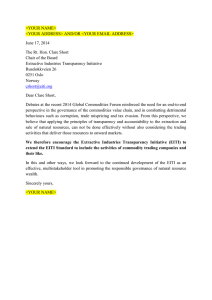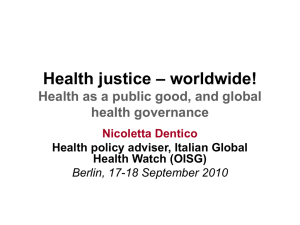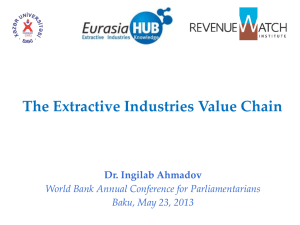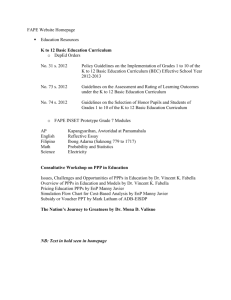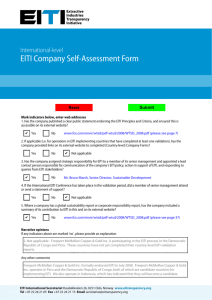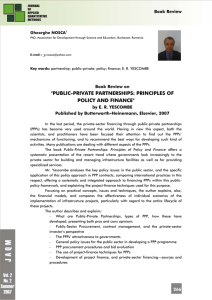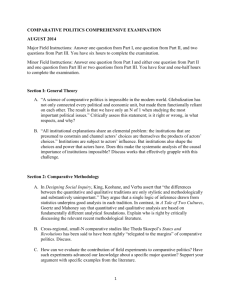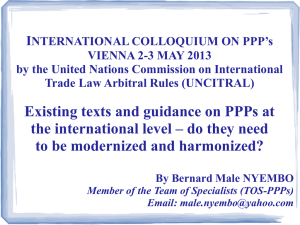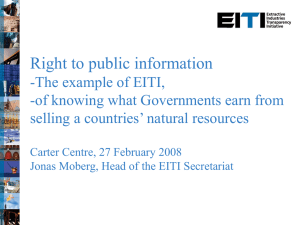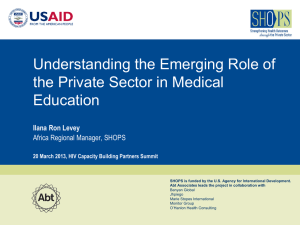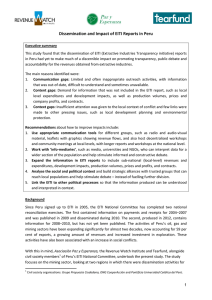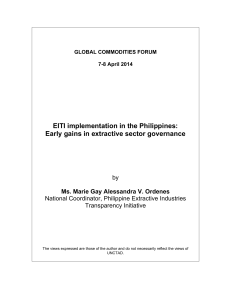Public Administration and Development Volume 31, Issue 1, Feb
advertisement
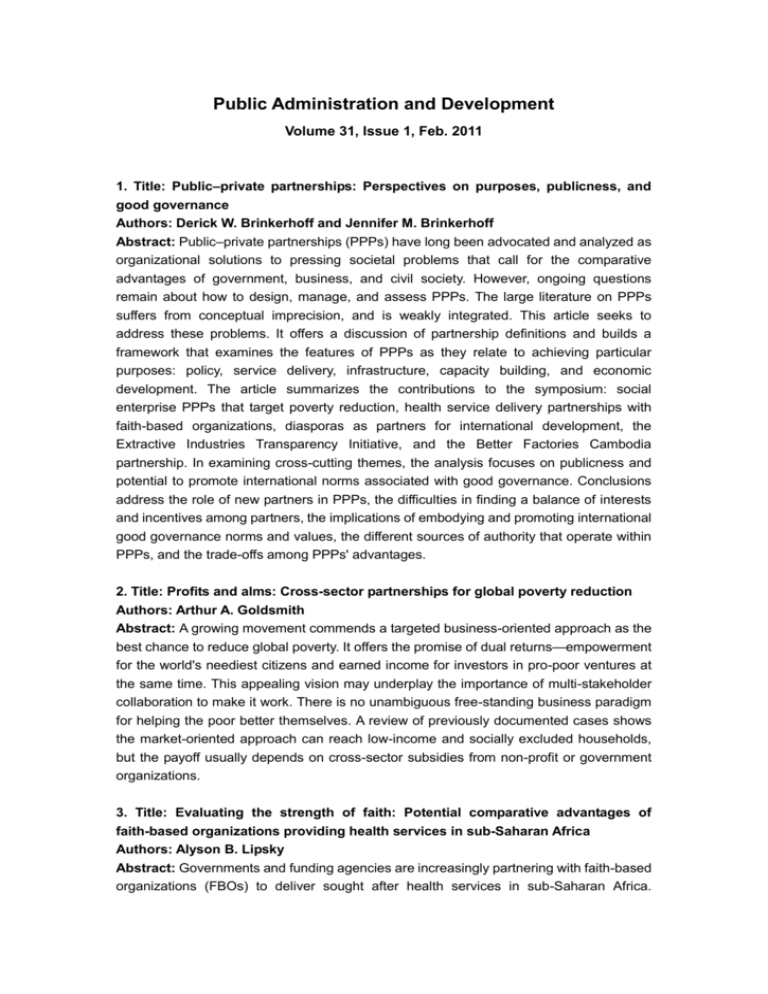
Public Administration and Development Volume 31, Issue 1, Feb. 2011 1. Title: Public–private partnerships: Perspectives on purposes, publicness, and good governance Authors: Derick W. Brinkerhoff and Jennifer M. Brinkerhoff Abstract: Public–private partnerships (PPPs) have long been advocated and analyzed as organizational solutions to pressing societal problems that call for the comparative advantages of government, business, and civil society. However, ongoing questions remain about how to design, manage, and assess PPPs. The large literature on PPPs suffers from conceptual imprecision, and is weakly integrated. This article seeks to address these problems. It offers a discussion of partnership definitions and builds a framework that examines the features of PPPs as they relate to achieving particular purposes: policy, service delivery, infrastructure, capacity building, and economic development. The article summarizes the contributions to the symposium: social enterprise PPPs that target poverty reduction, health service delivery partnerships with faith-based organizations, diasporas as partners for international development, the Extractive Industries Transparency Initiative, and the Better Factories Cambodia partnership. In examining cross-cutting themes, the analysis focuses on publicness and potential to promote international norms associated with good governance. Conclusions address the role of new partners in PPPs, the difficulties in finding a balance of interests and incentives among partners, the implications of embodying and promoting international good governance norms and values, the different sources of authority that operate within PPPs, and the trade-offs among PPPs' advantages. 2. Title: Profits and alms: Cross-sector partnerships for global poverty reduction Authors: Arthur A. Goldsmith Abstract: A growing movement commends a targeted business-oriented approach as the best chance to reduce global poverty. It offers the promise of dual returns—empowerment for the world's neediest citizens and earned income for investors in pro-poor ventures at the same time. This appealing vision may underplay the importance of multi-stakeholder collaboration to make it work. There is no unambiguous free-standing business paradigm for helping the poor better themselves. A review of previously documented cases shows the market-oriented approach can reach low-income and socially excluded households, but the payoff usually depends on cross-sector subsidies from non-profit or government organizations. 3. Title: Evaluating the strength of faith: Potential comparative advantages of faith-based organizations providing health services in sub-Saharan Africa Authors: Alyson B. Lipsky Abstract: Governments and funding agencies are increasingly partnering with faith-based organizations (FBOs) to deliver sought after health services in sub-Saharan Africa. Despite the fact that FBOs have been major providers of health services for hundreds of years, governments and funding agencies are increasingly seeking to formally partner with them, understanding that they can be found in most communities around the world, and may also be more effective than other types of non-governmental organizations (NGOs). However, there is currently no comprehensive theoretical framework to compare faith-based and secular non-profits. This article proposes an analytic framework for identifying potential FBO comparative advantages above and beyond those of NGOs, looking specifically at FBO health service delivery in sub-Saharan Africa. This article suggests that the most important comparative advantage that FBOs bring to health service delivery in sub-Saharan Africa is moral and ethical standing. 4. Title: David and Goliath: Diaspora organizations as partners in the development industry Authors: Jennifer M. Brinkerhoff Abstract: Diasporas are a potential resource for development and are receiving more attention from governments, international donors, and other development actors. Increasing rapprochement among these actors for the purpose of development may yield a mix of costs and benefits, depending on how it evolves. This article draws lessons from NGOs' experience; identifies diasporas' potential comparative advantages for development; illuminates limitations to their instrumentalization by these actors; and provides assessment tools and frameworks for informing strategic partnerships that can sustain diasporas' organization identity over time. Attention to diasporas as potential development actors rarely moves beyond remittances, though diasporas may embody a range of significant comparative advantages. For example, diasporans may come from the poorest, most marginalized places in their country of origin (COO), and may be the only actors with sustained reach and interest into these locations and populations. The analysis focuses on informing DOs' decision-making with respect to strategically partnering with governments and donors to advance shared development aims. On their part, if donors and governments seek to maximize diaspora development contributions rather than rushing to instrumentalize diasporas, they would do well simply to embrace diasporans as independent partners, not extensions of their own agendas. 5. Title: Limited partnership: Business, government, civil society, and the public in the Extractive Industries Transparency Initiative Authors: Susan Ariel Aaronson Abstract: This article assesses the Extractive Industries Transparency Initiative (EITI), a public-private partnership designed to help resource-rich countries avoid corruption in the management of extractive industry revenues. Thirty-two nations have adopted EITI, and the numbers of implementing nations are rapidly increasing. However, the EITI partnership is not as effective as it could be for three reasons. First, the partners (governments, civil society, and business) have different visions of EITI. Second, some implementing governments have not allowed civil society to participate fully in the process or have not consistently provided civil society with the information they need to hold their governments to account. In this regard it is a limited partnership. Third, in many participating countries, the public and legislators may not be aware of EITI. Thus, although public participation is essential to the success and potential positive spillovers of EITI, the public is essentially a silent partner, limiting the ability of the EITI to succeed as a counterweight to corruption. 6. Title: Public–private partnership in labor standards governance: Better factories Cambodia Authors: Anna Wetterberg Abstract: The growth of outsourcing in apparel manufacturing has raised concerns about increasingly exploitative working conditions. Given the failure of existing enforcement mechanisms, we need to look to alternate institutional structures to address the global challenge of declining labor standards. This paper examines the case of Better Factories Cambodia (BFC), a public–private partnership (PPP) that has effectively protected workers' rights through collaboration between the Government of Cambodia, the International Labour Organization, and multi-national apparel firms. Prior to the BFC, none of these actors was able to independently draw up and enforce stronger standards through effective monitoring. In collaboration, however, this mix of private, state, and inter-governmental organizations have been able to achieve the twin goals of stronger labor protections and effective enforcement by building on each partner's distinct organizational strengths. While this case may have broader relevance, its successes are tempered by dependence on a single industry and on buyers' preferences for inspected production sites. Further, similar partnerships may not emerge without strong state intervention to demonstrate their positive outcomes.
